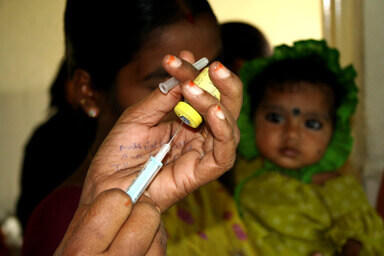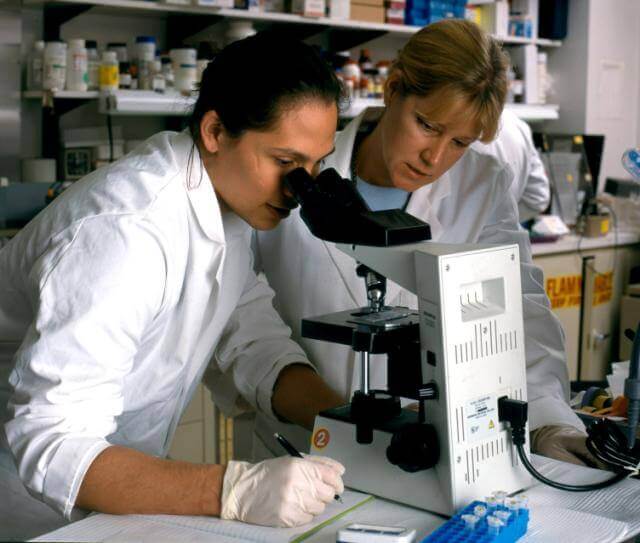- Global health R&D saves lives
Thanks to US support for global health R&D, millions of people around the world are living longer and healthier lives. Breakthrough technologies
have led to the elimination of smallpox and the near eradication of polio, and they have dramatically extended the lives of those living with HIV and AIDS.
The fruits of investment in global health innovation are undeniable—since 1990, the under-five child mortality rate has been cut in half,
maternal deaths have declined by 45 percent, and deaths from infectious diseases have dropped by around 25 percent.
- Global health R&D creates jobs and drives economic activity in the United States
Around 64 cents of every dollar spent by the US government on global health R&D goes directly to US-based researchers and product developers, creating
jobs, building US research and technological capacity, and providing a direct investment into the US economy. Across the nation, the life sciences
field is responsible for more than seven million jobs and contributes US$69 billion annually to the US gross domestic product.
- Global health R&D improves our nation’s security and keeps Americans safe
Infectious diseases like Ebola, HIV and AIDS, and pandemic flus know no borders. In today’s increasingly globalized world, the health of Americans and
the health of populations abroad are interdependent. To keep Americans safe, it is essential that we have the tools to detect, prevent, and treat
global diseases. To achieve this, the United States must invest in R&D now so we are fully prepared to tackle global health threats when they
emerge in the future.
- Global health R&D is a smart investment that promotes cost-savings
 The development of global health innovations like vaccines can product cost savings long term. Photo credit: PATHInvestments in global health research not only saves lives but also produces cost savings and efficiencies in the long term. For example, past research
has led to the creation of a polio vaccine that has nearly eradicated the disease globally. It is estimated that polio vaccinations have saved
over US$180 billion in direct treatment costs in the United States alone over the last half century. A new meningitis vaccine introduced in 2010
is expected to save about US$570 million over the next decade, and new treatment regimens under development for drug-resistant tuberculosis (TB)
could reduce the costs of treatment by up to 90 percent.
The development of global health innovations like vaccines can product cost savings long term. Photo credit: PATHInvestments in global health research not only saves lives but also produces cost savings and efficiencies in the long term. For example, past research
has led to the creation of a polio vaccine that has nearly eradicated the disease globally. It is estimated that polio vaccinations have saved
over US$180 billion in direct treatment costs in the United States alone over the last half century. A new meningitis vaccine introduced in 2010
is expected to save about US$570 million over the next decade, and new treatment regimens under development for drug-resistant tuberculosis (TB)
could reduce the costs of treatment by up to 90 percent.
- Global health R&D drives economic growth in developing nations
By producing technologies that make people healthier and increase their productive years, global health research can drive economic growth in developing
nations. The Lancet Commission on Investing in Health found that nearly one quarter of all economic growth in low- and middle-income countries
between 2000 and 2011 was attributable to increases in individual health and productivity brought about through improvements in health systems
and investments in health innovation. As developing nations continue to work in partnership with the United States to strengthen their health systems
and economies, the need for US assistance will be reduced over time.
- Global health R&D protects US troops and citizens who work or travel abroad
US investments in the development of new tools to prevent, diagnose, and treat diseases such as TB, dengue, and malaria can help protect US citizens
serving in the military, traveling, or working abroad in regions that put them at risk. The US Department of Defense (DoD) has been instrumental
in advancing a variety of global health technologies for that purpose. For example, the agency supported the development of the first vaccine for
Japanese encephalitis and the malaria vaccine candidate RTS,S. DoD programs also conduct ongoing research toward the development of an HIV and AIDS
vaccine and new prevention and treatment options for malaria and other tropical diseases.
- Investments in global health R&D demonstrate America’s character and strengthen US relations around the world
 Investments in global health R&D demonstrate our nation's character. Photo: PATH/Gabe BienczyckiThe United States is the largest supporter of global health R&D in the world. US investments in global health research are an expression of our
nation’s compassion and dedication to improving human lives worldwide, as well as an important instrument of foreign policy and diplomacy. US-led
global health knowledge-sharing and capacity-building activities enhance our diplomatic relations with other nations, and US-supported global health
innovations can strengthen fragile states by promoting improved health, economic development, and stability.
Investments in global health R&D demonstrate our nation's character. Photo: PATH/Gabe BienczyckiThe United States is the largest supporter of global health R&D in the world. US investments in global health research are an expression of our
nation’s compassion and dedication to improving human lives worldwide, as well as an important instrument of foreign policy and diplomacy. US-led
global health knowledge-sharing and capacity-building activities enhance our diplomatic relations with other nations, and US-supported global health
innovations can strengthen fragile states by promoting improved health, economic development, and stability.
- US investments in global health R&D have a multiplier effect
To support global health product development, the US government works in partnership with the pharmaceutical and biotechnology industries and academic
and philanthropic sectors to leverage US investments in global health R&D and enable partners to bring their complementary skills, capabilities,
and comparative advantages to bear. Investments made by the United States are matched with inputs from other sectors, meaning the impact of each
US government dollar invested is multiplied.
- Global health R&D helps the Unites States maintain its long-term competitiveness in medical innovation
While the US is undoubtedly the global leader in medical innovation, other traditional funders—and emerging nations like China—are increasing
their investments and competitiveness in the industry. For example, China’s share of the global pharmaceutical industry output increased seven-fold
between 1995 and 2010—from 2.5 percent to 18.3 percent—while America’s share remained steady around 26 to 27 percent. If the United
States wants to remain the global leader in medical innovation, our government must continue to support strong investments in medical research,
including funding global health research and product development.
- A majority of Americans support US investment in global health R&D
There is strong support among both the American people and businesses for the United States to invest in new global health advancements. A 2011 poll
commissioned by Research!America found that 78 percent of Americans believe it is important for the United States to support global health research.
The same poll found that 76 percent of Americans believe that global health research and development is important to the US economy.



